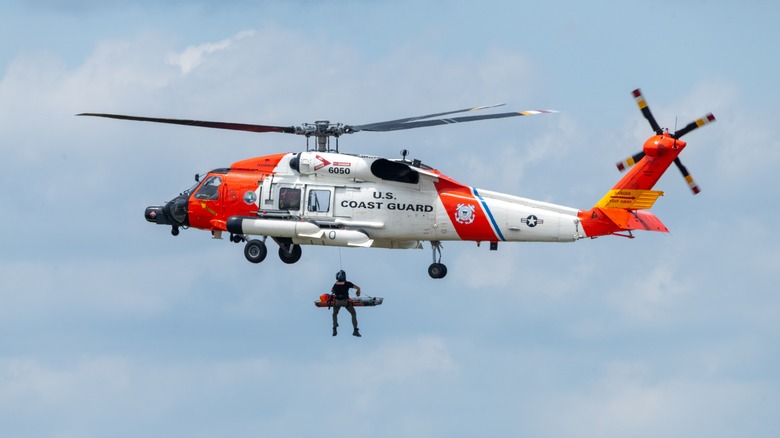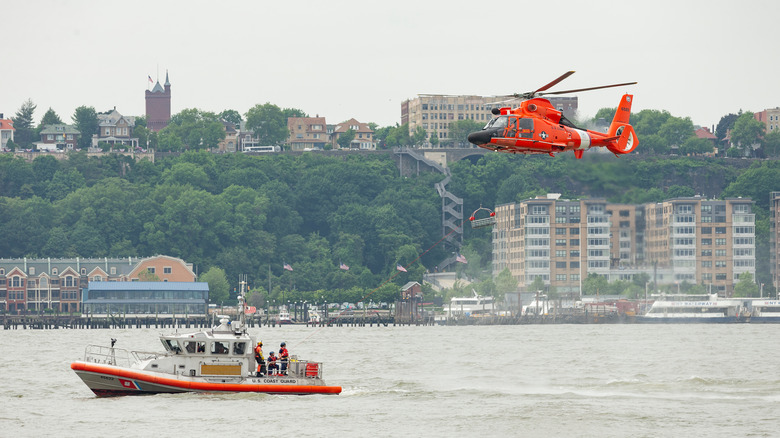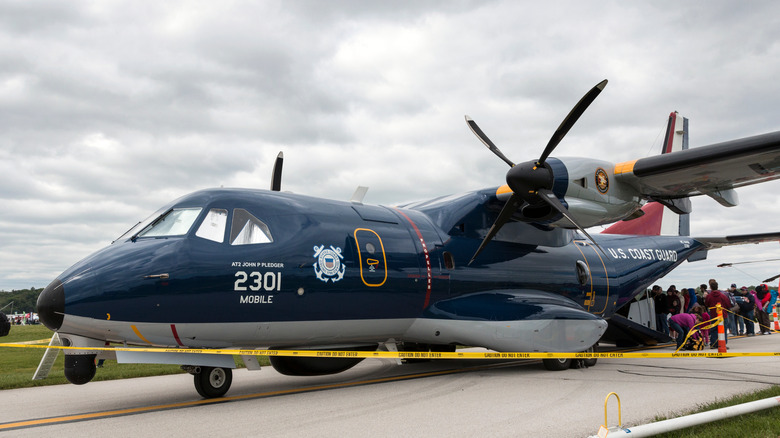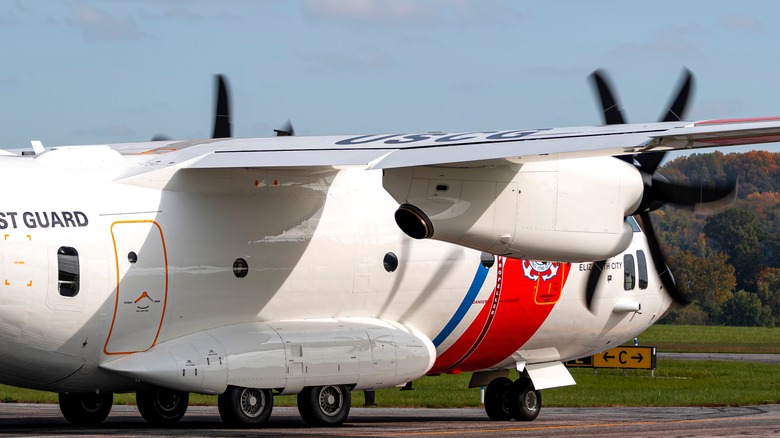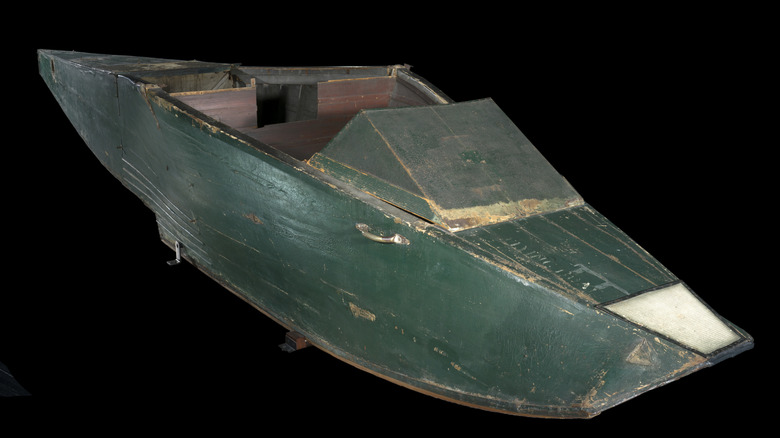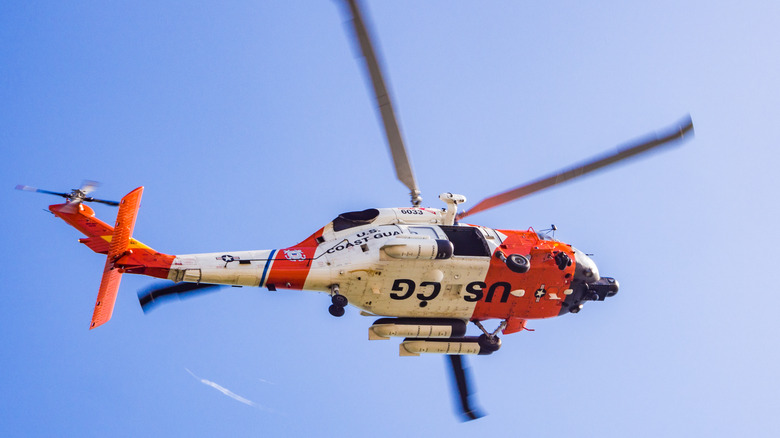What Kind Of Aircraft Does The Coast Guard Fly & Has It Ever Used A Helo Carrier?
Earth's oceans are vitally important, fascinating, perilous places. Whether you're traveling them for business or pleasure, it's an enormous relief to know that they're patrolled by the coast guard. The invaluable work of the institution can't be overestimated: The United States Coast Guard reports that it's responsible for saving approximately 3,500 lives annually.
This work, of course, would be impossible without the sophisticated equipment the coast guard has access to. Needless to say, boats and ships of a variety of sizes and functions are among their primary assets, with the United States Coast Guard owning and operating a total of 1,861 vessels (259 of which are dubbed Cutters as they are "65 feet or greater in length"). Among their number are small and medium response boats (367 and 174 of which respectively), 11 harbor tugs and 117 motor life boats.
This range of seafaring vehicles (which has included the extraordinary Eagle cutter) is crucial to allowing the coast guards to adapt to the various different situations they may face, but to keep them as adaptable as possible, they also have access to a fleet of very different vehicles: Aircraft. There are certain operations, vantage points, and tactics that are far better suited to an aerial approach, which is where this very different weapon in the United States Coast Guard's arsenal comes in.
The current types and quantities of the United States Coast Guard's helicopters
The United States Coast Guard's official fleet of aircraft is far more modest than its seafaring vehicles: 200 in total (59 less than the number of cutters it has). The majority of their number (143) are helicopters, coming in two different varieties: the MH-65D/E (of which there are 98 in the inventory) and the MH-60T (45 of those).
The MH-65D/E is an enhanced version of the H-65, appropriately named the Dolphin. As of 2024, the venerable Dolphin has served with the U.S. Coast Guard for forty years. It's a valuable and versatile Eurocopter America workhorse, intended for short range (the MH-65C has a range of 290 NM) rescue and recovery missions and capable of performing them from aboard cutters. With a dedicated rescue swimmer in the crew and the capacity for night missions, it's a trusty bird that has undergone consistent upgrades and improvements to retain its important position. The MH-65C is equipped with dual Turbomeca Arriel 2C2-CG engines that can propel it at 175 knots, and the model also features a primary M240B/H gun at 7.62mm for some offense.
The MH-60T, meanwhile, is a Sikorsky model, a similar recovery helicopter that boasts a better range at 700 nautical miles and GE T700-GE-401C turboshafts offering a speed of 180 knots. The MH-60T is an upgrade from the HH-3F Pelican, they have a similar all-conditions versatility but, with that additional range, much more scope for search and rescue endeavors too.
The airplanes in the United States Coast Guard's fleet
The United States Coast Guard has a greater variety of airplanes: Its inventory lists 57 airplanes altogether, of five different varieties. The most numerous among them is the HC-144, of which the Coast Guard has 18. Developed under the European Aeronautic Defense and Space Co, it's another modestly sized aircraft tailored to the needs of the coast guard. Slightly over 70 feet long and with a wingspan of almost 85 feet, it was introduced to take the place of earlier models like the HU-25, upgraded with some advanced functionality including the C4ISR system, thereby supporting its designation as Ocean Sentry. The United States Coast Guard notes that these systems help the organization "fulfill its maritime patrol, drug and migrant interdiction, disaster response, and search and rescue missions more effectively."
The HC-130H and the advanced model, the HC-130J (of which there are 10 and 13 respectively in the inventory), are flexible models design around the notion of surveillance further afield, with the J variant boasting a FLIR Systems Star SAFIRE III for advanced imaging capacity. The coast guard's currently active airplanes are rounded out by a duo of C-37A/Bs. The B arrived with the organization in July 2022, with the Coast Guard reporting that "the aircraft's overall mission is to operate as a command-and-control platform anywhere in the world for the secretary of Homeland Security, the commandant of the Coast Guard, and other top DHS leadership." That's not all, though.
Past and future United States Coast Guard aircraft
The aforementioned HC-130H/J, C-37A/B and HC-144 account for all but 14 of the Coast Guard's aircraft. The remaining 14 are HC-27Js, a very new model. Adaptation from the C-27J Spartan began with 2014's National Defense Authorization Act, with the intent of modifying the aircraft to occupy a similar role in the Coast Guard's repertoire as the HC-144.
Aircraft nicely complement and support the Coast Guard's reconnaissance, tracking, and rescue efforts, as is clear from the uses their aircraft are designed for. This also explains why the Coast Guard has utilized an interesting range of aircraft over the years. The history of Coast Guard helicopters dates back to World War II, the National Naval Aviation Museum reports, with Admiral Ernest J. King, Chief of Naval Operations, assigning to the Coast Guard "responsibility for the seagoing development of the helicopter." It wasn't until 1943 that the organization received its first operational model. It was a Sikorsky, the HNS-1: A 75 mph helicopter offering 200 horsepower with its Warner R-550-3. This aircraft soon emerged as a key element of Coast Guard operations, and the maneuverability and resilience of helicopters would remain an important asset for them over eighty years later.
Twenty years prior to this, the U.S. Coast Guard wielded early airplanes. In June 1925, an O2U-2 under Coast Guard control intercepted smuggling operations. The first airplanes to be used by the organization would, technically and most aptly, be dubbed seaplanes instead.
The Coast Guard's first seaplane and pilots
The United States Coast Guard's modern incarnation was born in January 1915, with the blending of the U.S. Life-Saving Service and the Revenue Cutter Service. This early in the 20th century, and just twelve years after the Wright Flyer made history with its inaugural flight, airplanes were still something of an unknown entity. Their potential place in the Coast Guard, and in the wider world, was very much up in the air (aviation pun thoroughly intended).
It was Lieutenant Elmer Fowler Stone who would perform a prominent role in highlighting the potential connection between the Coast Guard and these new flying machines. Stone would fly in a flying boat designed by Glenn Curtiss, a vehicle described by Colonel Robert H. Rankin and Norman N. Rubin's "The Story Of Coast Guard Aviation" as "a triplane flying boat with short, boat-like hull and with the control surfaces mounted high to the rear on tail booms." In 1916, Ellsworth Bertholf of the Coast Guard asked Curtiss to develop one of the machines for the organization. Per United States Coast Guard Aviation History, the Model F Flying Boat from Curtiss was the very first airplane used by the Coast Guard the previous year, though it was not strictly the organization's own model.
Pensacola Naval Aviation Training School trained Coast Guard pilots early in 1917, and that April, they had their first experience deployed at shared naval bases. These were crucial steps toward the fleet of today.
The origin of the Coast Guard's Helo Carrier story
April Fools jokes can be harmless fun, but they can also be potentially very dangerous misinformation. In 1957, the BBC show "Panorama" managed to convince some in the U.K. that spaghetti grew on trees through joke 'documentary' footage, and in 2016, the Coast Guard tried to fool Facebook into admiring its supposed new carrier.
"With the Coast Guard's latest budget approval, the Acquisition Department has gone full throttle! Check out the newest Coast Guard Cutter, the CGC Seaman Gublatz," Go Coast Guard posted on Facebook, accompanied by an image of a U.S. Coast Guard-branded carrier. There is no such carrier, but there's a curious wrinkle to this tale hidden away in Go Coast Guard's replies. "We actually did have the world's first helo-carrier, the USCGC Cobb. Like the Navy's Langley, it was ship converted to a flat-top," the account writes.
USCGC Cobb began life as the Governor Cobb, a 1906 Eastern Steamship Company creation The New York Times noted to be "the first turbine steamship ever built." It was recommissioned as the Coast Guard's, and the world's, first helo carrier in 1943, at 289 feet long and with a 38-by-63 feet netted landing deck added. Though it would serve in this capacity for only around two and a half years, owing to frequent maintenance needs, it's nonetheless evidence that the Coast Guard has indeed used a helo carrier, though not the one the April Fools joke has suggested which would still be smaller than a cruise ship.
